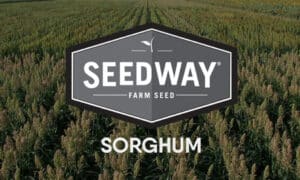Filter Products-
-
Maturity
-
Maturity Days
-
Stalk Strength
-
SG 5643XTF
Tawny line with quick, even emergence to get the variety off to a great start. A consistent variety across various yield environments and soil types, this variety is one to plant with peace of mind. This bean is a chloride excluder and has a strong resistance to Root Knot Nematode, Soybean Cyst Nematode, and Frogeye Leaf Spot.

Maturity Group: 5.6
Learn more → -
SG 6243XTF
A tawny, medium-statured bean with great standability and agronomic package. This line is resistant to Soybean Cyst Nematode, Root Knot Nematode, and Stem Canker, giving it a nice shield throughout the season to pack on the pods and produce top-notch yields.

Maturity Group: 6.2
Learn more → -
SGS 255C (Grain Sorghum)
Learn more →SGS 255C is widely adaptable north to south across various soil types and conditions of the medium-early maturity zones. Exceptional stress tolerance allows for dependable yield performance under adverse conditions. Good emergence score and early vigor help SGS 255C get a fast start in spring.
-
SGS 425 (Hybrid Grain Sorghum)
Learn more →SGS 425 is widely adapted from north to south across various soil types and environmental conditions. Good emergence and early vigor help SGS 425 get off to a fast start, while unmatched stress tolerance allows for dependable yield performance under adverse conditions. If you need a medium maturity hybrid with high yield potential, SGS 425 is the variety to ask for.
-
SGS 801 (Hybrid Grain Sorghum)
Learn more →SGS 801 is widely adapted from north to south across various soil types and environmental conditions. Good emergence and early vigor help SGS 801 get off to a fast start, while exceptional stress tolerance allows for dependable yield performance under adverse conditions. If you need a early maturity hybrid with high yield potential, SGS 801 is the variety to ask for.
-
Shockwave BR
Learn more →Shockwave BR combines a BRANCH ROOTED trait with excellent disease resistance to deliver outstanding performance. Performs better in higher water tables. High forage yield makes it a productive variety in both normal and wetter conditions. 3-4 cut management. Seed at 18-20 lbs. alone, 8-12 lbs. in mixes
-
Shockwave II
Learn more →Shockwave II delivers the next generation of branch root trait performance, persistence and yield that growers have come to expect. The branch-rooted trait improves root protection during periods of freezing and thawing, as well as improved tolerance to high water tables. Its improved disease package enhances seedling survival and stand establishment under adverse conditions. Shockwave II is protected by a perfect disease resistance index rating, including high genetic resistance to multiple strains of Aphanomyces Race 1 and Race 2 root rot.
-
SiloSolve® AS (Aerobic Stability)
Learn more →Most farmers experience heating of silage largely due to growth of yeast and mold. Good management, including proper compaction, reduces the heat. However, some crops, such as corn, heat more often than other crops.Yeasts & molds are fungi that grow well in the presence of oxygen. Yeasts initiate the heating of silage and molds usually follow. Certain molds produce harmful mycotoxins. Mycotoxins may compromise production and health of animals.

-
SiloSolve® FC (Fungal Control)
Learn more →Heating of silage largely due to the growth of yeast and mold is problematic for feed out. Certain molds
produce harmful mycotoxins which may compromise production & health of animals. Another challenge could
be feed shortage, forcing farmers to initiate feed out well in advance of the optimum 90 days of fermentation. This is problematic as it will not allow the silage to reach a stable stage. The risk of heating & loss of valuable nutrients may jeopardize milk production & could lead to a severe economic impact.
-
SiloSolve® MC (Microbial Control)
Learn more →Clostridia grow in wet silage when there is a lack of oxygen. Growth of clostridia leads to breakdown of protein and butyric-acid production. Silage with clostridia has a strong butyric-acid smell and elevated pH, which can reduce palatability. SILOSOLVE® MC contains three strains of lactic-acid bacteria. One patented strain reduces undesirable micro-organisms such as clostridia. The others improve overall fermentation.

-
SPRINT MAXX BLEND
Learn more →Sprint Maxx is a forage blend of Haywire Brand Oats and Stockade Brand Peas. It produces high yields of high quality forage in dairy and beef areas throughout the Northern United States. Sprint-Maxx provides a quick source of forages within 60 days of planting and can be used as companion crop to establish alfalfa or it can follow winter wheat if planted within the first 2 weeks of August. Seed at 80-120 lbs. per acre.
-
SSA 171 BMR6 DS (Forage Sorghum)
Learn more →SSA 171 BMR6 DS is a brown midrib, male sterile hybrid forage sorghum that reaches harvest maturity approximately 75 days from planting. Because the lignin content of the stalk has been dramatically reduced, digestibility improves by 35%over conventional forage sorghums. SSA 171 BMR6 DS forage sorghum, with this improvement in digestibility and palatability, can equal the milk production of rations of corn. Plant at the recommended rates for your area and harvest timely for optimum yield and quality. The water requirement for SSA 171 BMR6 DS is 1/3 less than would be required to produce an equivalent amount of corn. Because SSA 171 BMR6 DS is a male sterile hybrid, volunteer growth is not an issue provided there is adequate isolation from pollen fertile sorghums.







